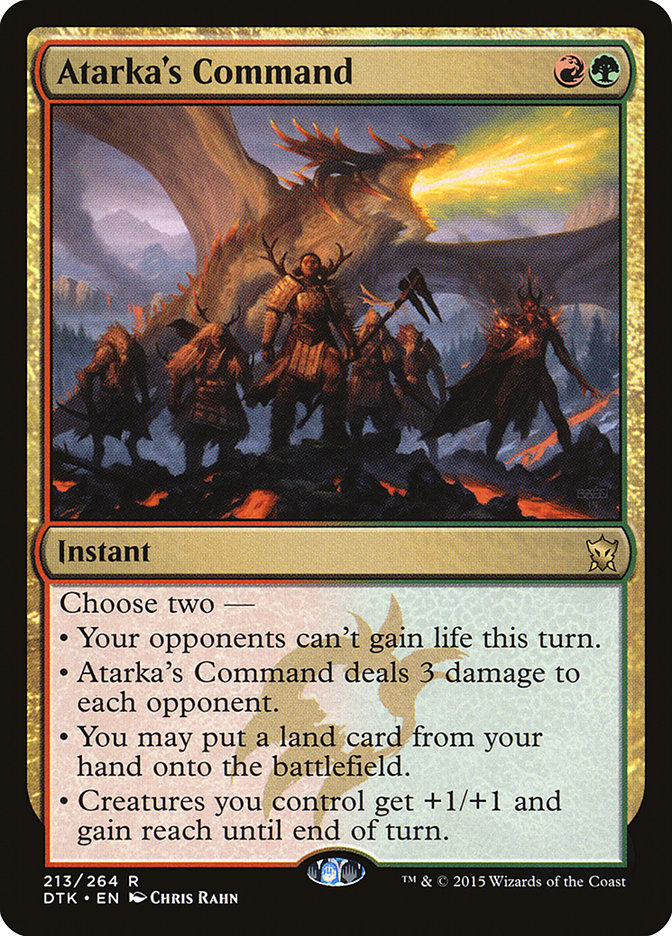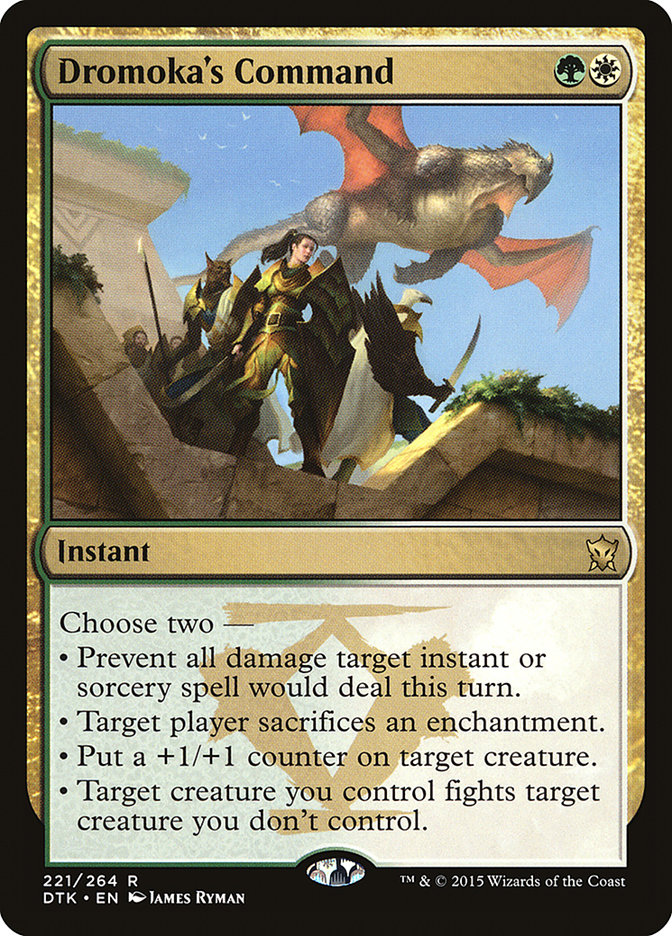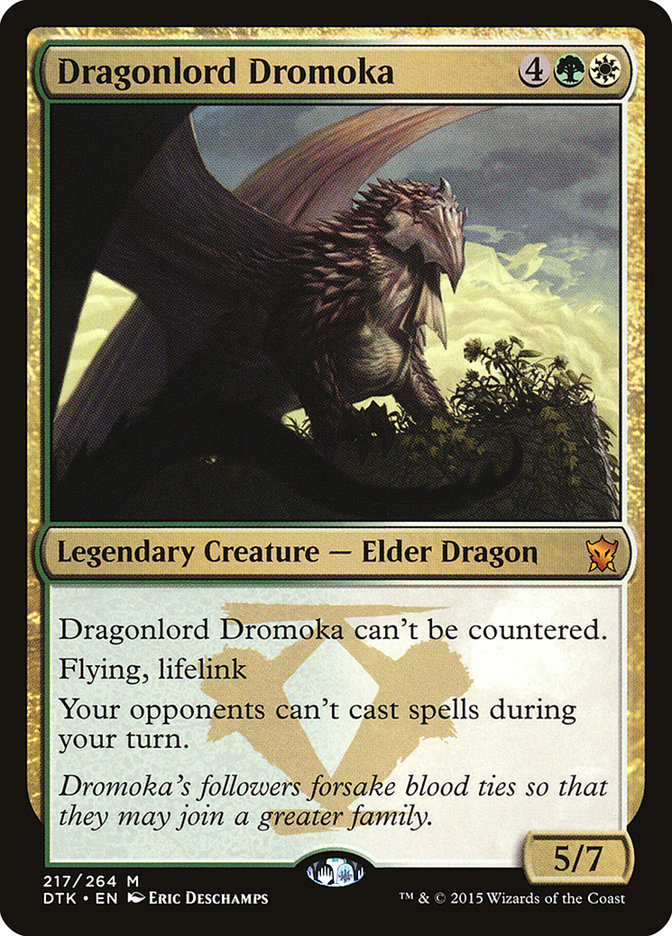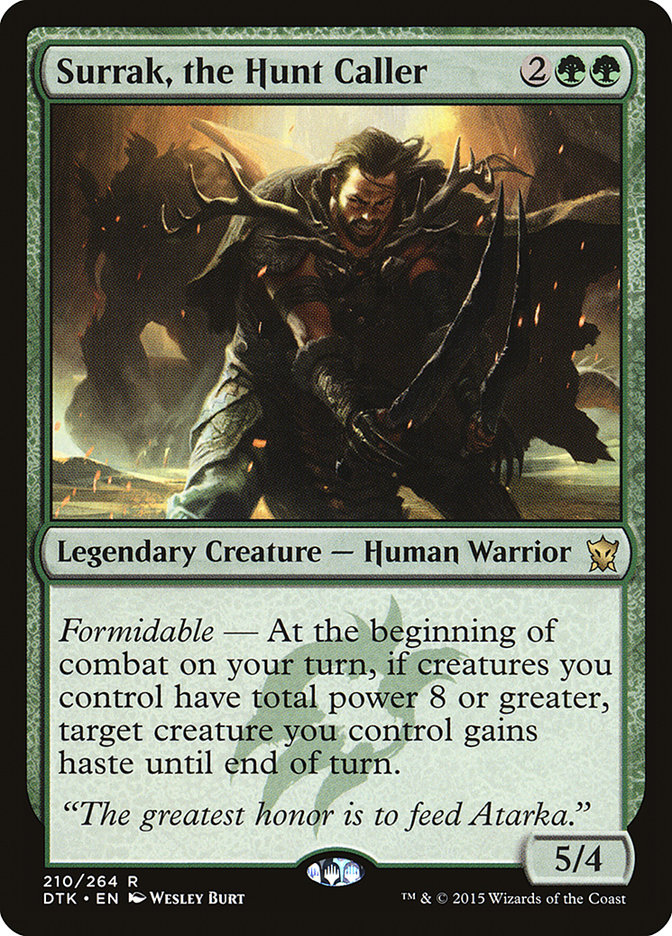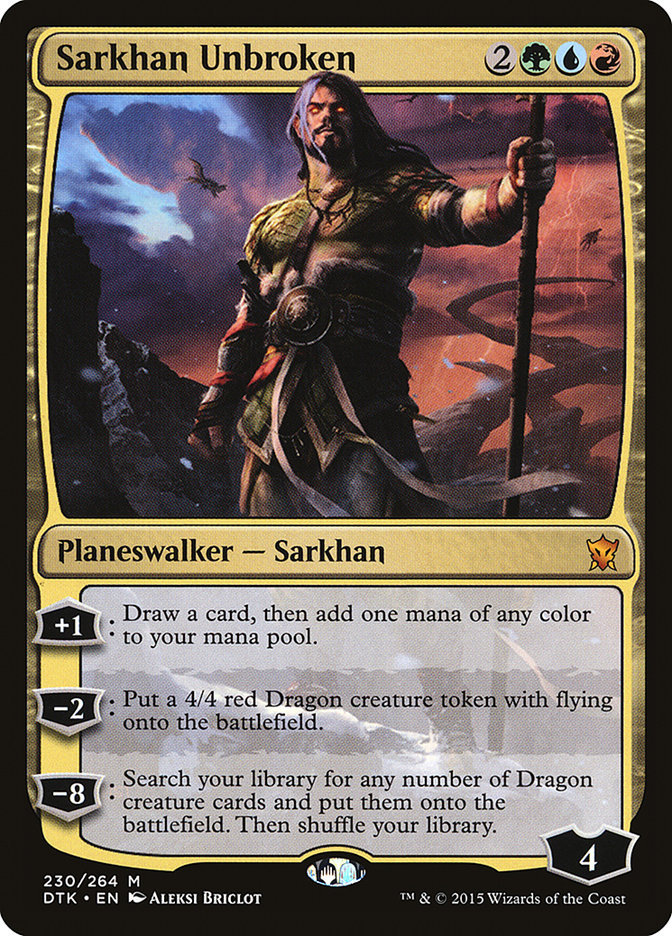Spoiler season always feels a little bit like Christmas, with all the new toys we’ll spend the next year playing with slowly being revealed to us. And,
just like at Christmas, how happy we are about what we get depends a lot on how close it is to what we were hoping for.
Last week
, I shared my thoughts on all of the dragons that had been revealed so far, along with my hopes that we’d see a Dragonlord Atarka that fit snugly into the
aggressive G/R dragon deck that I was putting together in my head. Then, when Atarka herself was finally revealed – the same day my article went up,
amusingly enough – I was disappointed that she wasn’t the present I’d asked for on my Christmas list.
My thought, at the time, was that we’d already seen a huge seven-cost version of Atarka in Fate Reforged and that it would be nice to get a new version
that fit well in an aggressive strategy, since that’s what the G/R color combination typically entails. I was hoping to see something along the lines of
what we got from Kologhan: an efficient creature that could be top of the curve for an aggressive midrange creature deck. The Atarka we got, however, was
nothing like that.
At first, I was disappointed, because – like a kid on Christmas morning who got a truck instead of a train – I hadn’t gotten what I wanted. But when I
thought about the card from the perspective of the world and the story, I realized that it would not have made sense for Atarka to be the card that I
wanted her to be. She is the head of the clan that reveres ferocity and strength above all else. How could she not be the biggest, baddest dragon
of them all?
And that’s what she is. Dragonlord Atarka is an enormous monster, an 8/8 Flying, Trampling, spewing-hot-fire all over your opponent’s creatures and
planeswalkers kind of monster. The closest comparison to a previous creature is something like Bogardan Hellkite, which cost one more mana for a
much smaller body. Atarka traded flash and the ability to send her enters-the-battlefield damage to the opponent’s face for trample and +3/+3, which seems
like a totally reasonable exchange, especially when you factor in the mana discount.
While it can’t finish off your opponent directly, the five damage that Atarka deals when she enters the battlefield is the perfect foil for quite a few
popular cards in Standard. She burns Siege Rhinos to a crisp and exactly finishes off an Elspeth, Sun’s Champion who has ticked up to make soldiers.
Similarly, Atarka can incinerate a Whisperwood Elemental when she hits the table, or mop up a pair of manifests that it left behind. In most cases, I’d say
an 8/8 flying trampler wouldn’t have to attack very many times to end the game, but as the G/W Devotion matches at GP Miami showed us over the weekend,
sometimes you need to slog through a whole lot of life in order to win the game.
Dragonlord Atarka may not have been what I was hoping for, and she may not go in the deck where I wanted to play her, but she’s still awesome, and she’ll
certainly see play. I can see her easily fitting into the existing G/R Devotion shell, where she can help provide some much-needed removal, as well as a
way to break through in games that stall out on the ground. I’m not sure if she’ll replace Ugin at the top of the curve in those decks, but she is one mana
cheaper and doesn’t hurt your own board when she destroys your opponent’s, the latter of which is especially attractive to a deck that tends to accumulate
a lot of permanents. The fact that Atarka costs seven mana also means that Ugin himself can at best trade with her with his minus ability, since he has
seven starting loyalty. Even if your opponent plays Ugin first and uses his plus ability, you can always play Atarka and breath fire all over him, so
there’s no way for your opponent to clear the board and keep a Spirit Dragon when Atarka’s around.
Even Ugin can’t push aside Dragonlord Atarka and live to tell the tale. Now that is a badass dragon.
My reaction to Atarka’s Command had a pretty similar trajectory to my thoughts on Atarka herself. My first thought was that the collection of abilities
didn’t seem like something that fit into the kind of deck that I wanted it to, so I was disappointed. But with a little more reflection and opening my mind
a bit to other decks, I’ve realized that Atarka’s Command is pretty much bonkers.
The most important mode on Atarka’s Command is the damage one. Dealing three damage to a player for two mana isn’t in itself outstanding, but it’s a
totally fine rate. Add on the “opponents can’t gain life” clause and you have Skullcrack, which is already a Modern playable card for the same converted
mana cost.
With Skullcrack, you’re overpaying a bit for the damage that you’re getting in situations where you don’t care about opposing lifegain compared to
something like Lava Spike or Lightning Bolt. But with Atarka’s Command, you have the option to choose a different mode when you’re not responding to
something like Siege Rhino. The ability to give your creatures +1/+1 and reach for the turn may not seem like much, but when you’re playing a deck like
Burn, squeezing every last point of damage out of your cards matters quite a bit.
If you have a single creature hitting your opponent, Atarka’s Command with the damage and +1/+1 mode is as efficient as Boros Charm. With two creatures
connecting, it’s the single highest damage card in your deck. And, for a deck as packed to the gills with every efficient burn spell in Modern Magic,
that’s really saying something.
It’s also worth noting that Atarka’s Command isn’t just offering damage. It’s also offering a combat trick combined with damage. One of the best cards in
my Modern Abzan Aggro deck against Burn was Voice of Resurgence, because it could easily blank opposing Goblin Guides and stymie Monastery Swiftspears on
turn 2, and outside of Searing Blaze, Burn didn’t have a great way to get past it without burning a significant amount of damage.
With Atarka’s Command though, you can send Goblin Guide into a Voice of Resurgence with no qualms about the consequences, since you can just choose to deal
three damage to your opponent and pump your Guide to keep it alive. And if you’re actually attacking with more than one creature, you’re not only keeping
the blocked one alive, but you’re also getting in an extra point of damage with the other! In a matchup that can come down to just a couple of life points
in a race, that’s a big deal.
Atarka’s Command is assuredly going to see play in Modern in Burn, since it really does everything that deck wants – prevents lifegain, deals damage
efficiently, and even dodges Leyline of Sanctity since it doesn’t target!
It will likely find a home in aggressive Standard decks as well.
In Standard, Atarka’s Command threatens to combine very powerfully with the already very powerful Goblin Rabblemaster. While previously Courser of Kruphix
could safely block and kill a Rabblemaster without too many friends, now Atarka’s Command can pump that Rabblemaster so it wins the fight, while
simultaneously pumping all of its friends that are hitting you in the face! The fact that it can also negate the lifegain from the ever-present Siege Rhino
makes me think that Atarka’s Command is likely to find itself a home in many aggressive R/G decks in Standard – even if Atarka herself does not.
It is a little strange to me that Atarka’s Command seems like it will never be used in the same deck as Atarka. The “Explore” mode on the Command seems
almost tacked on to the otherwise ultra-aggressive card as a nod to the size and cost of its namesake. That said, even if Atarka’s Command isn’t likely to
see play primarily as a mana ramp effect, it can still lead to some interesting situations where you can accelerate into a big creature faster than your
opponent is prepared to deal with.
The fact that Atarka’s Command is an instant means that you can potentially play it during your opponent’s end step to get an additional land onto the
battlefield. This can let you play something bigger than they were prepared to deal with on your turn. For example, your Abzan Midrange opponent might hold
up three mana for Hero’s Downfall to kill Stormbreath Dragon heading into your fifth turn, but they may tap out for Read the Bones before your fourth. With
Atarka’s Command, you can fire off three damage and an extra land at the end of their turn, and then untap and slam Stormbreath to hit them while they’re
tapped out.
Who said red decks don’t have any subtlety to them?
When Atarka’s Command was first revealed, one of the reasons I was initially disappointed is because I had expected one of the modes to be a fight effect.
Pit Fight was a Gruul hybrid card back in Return to Ravnica block, so it seemed natural to me that the G/R charm would include that as one of its modes.
But when I later saw Dromoka’s Command, all was forgiven.
While the fight effect might have fit better from a color pie perspective on the G/R charm, from a mechanical needs perspective, it’s much better on
Dromoka’s Command. Red decks have access to burn spells for removal, while G/W decks traditionally don’t have very many ways to interact with the
opponent’s board. Dromoka’s Command changes all that, offering the ability to take down opposing creatures with your own – and then some.
Dromoka’s Command may be the best card in all of Dragons of Tarkir. That may seem like a stretch, but every single mode on the card is excellent. The fight
mode is likely to be the most commonly used, in particular in combination with the +1/+1 counter ability to win otherwise fair fights. But both other modes
are also quite good, especially given the texture of the Standard format right now.
The rise of the G/W Devotion deck that took first and second place at Grand Prix Miami, along with the popularity of cards like Outpost Siege and Chained
to the Rocks, has highlighted the importance of enchantments in a way that Theros block never really did. While we saw a few maindeck copies of cards like
Destructive Revelry during the reign of Whip of Erebos, enchantment removal never really became a priority, mostly because it was too narrow and dead
against too many decks. We’ve seen Sultai Charm do a lot of work recently to offer decks that can support it the ability to kill Mastery of the Unseen and
the like while retaining usefulness against other decks, but Dromoka’s Command goes a step beyond that.
Dromoka’s Command not only offers versatility in dealing with opposing enchantments but also value while doing so, since “Target player sacrifices an
enchantment” is just one of the two modes you get to pick. “Fleecemane Lion fights Goblin Rabblemaster, and you sacrifice Outpost Siege” is a line I expect
to hear quite often in the coming months. Or “Fleecemane Lion fights Voyaging Satyr, and you sacrifice Courser of Kruphix” – both total blowouts.
Or how about “Prevent all damage from Stoke the Flames. You sacrifice Chained to the Rocks”? The “prevent all damage target instant or sorcery spell would
deal this turn” mode is also a giant blowout. Standard is a format with a lot of aggressive decks that rely on getting in early damage and
finishing the game with cards like Stoke the Flames and Crater’s Claws, and Dromoka’s Command is incredible against pretty much everything those decks do.
Dromoka’s Command is going to be a powerful tool in the arsenal of any deck that can play it. It’s not the kind of card that spawns decks built around it,
but it is the kind of card that can allow for decks that might otherwise not be playable to exist. Expect to see a lot of it over the next few years. I
know I’ll be playing it.
Unlike Atarka and her Command, Dragonlord Dromoka works very well with hers. Giant lifelink creatures that prevent your opponent from responding to
anything you do on your own turn go very, very well with fight effects. That said, I doubt Dromoka will see nearly as much play as her Command. While a 5/7
lifelinking flier that can’t be countered and locks your opponent out of playing spells on your own turn is a very powerful combination of abilities, it
doesn’t match up very well against the plethora of quality black removal spells in Standard.
It’s hard to justify spending six mana on a creature that doesn’t have an immediate impact on the game when it enters the battlefield. Even though your
opponent can’t counter it, they can still respond to it by using removal spells on your other creatures, and then wait until their own turn to kill Dromoka
herself. At six mana, it’s difficult to set up a situation in which you can use Dromoka and her ability to prevent your opponent from countering some other
powerful game-winning spell.
Then again, Dromoka is basically a pre-cloaked Rith, the Awakener or Baneslayer Angel, so I’d love to be wrong. I love big, powerful creatures that can
take over games on their own, and Dromoka is exactly that. She’s big enough to survive Atarka’s enters-the-battlefield trigger, and lifelink means that she
can likely race even an 8/8 flier, so there isn’t much that really trumps her creature-wise, except perhaps Stormbreath Dragon’s protection from white or
Dragonlord Silumgar stealing her to work for your opponent.
I’m certainly going to build decks with Dromoka, because she’s sweet and exactly the kind of card that I like, but I’m hard pressed to see her ever really
taking over any format.
I liked the old Surrak, but he was never quite good enough to justify playing. He cost a little too much for what he did, and – as I fear will be the case
with Dromoka – didn’t do enough the turn you played him to warrant his vulnerability to removal. This Surrak, on the other hand, is a much better deal, and
can potentially impact the board right away.
Haste is a very powerful ability, especially when you can dole it out wherever you want. Temur Ascendancy is a card that has always felt like it fell just
short of playable to me, since paying three mana for a card that didn’t immediately impact the board was just a little too much. Surrak, on the other hand,
offers a totally reasonable body – a 5/4 for four mana – with the ability to give haste to your other creatures attached.
Now, Surrak can only do this if you can trigger Formidable, which means you have to have eight or more total power in play. Given that Surrak represents
five of that amount, that’s not a lot to ask. You can easily play a first turn Elvish Mystic, second turn Rattleclaw Mystic, and attack with Surrak on your
third turn – with a mana open for Stubborn Denial, if that’s your thing.
And Surrak not only gives himself haste but gives haste to each creature you play after him as well. Because he can only affect one creature each turn, he
doesn’t work with something like Saproling Burst like the old Fires of Yavimaya combo, but he can send in a new giant monster to smash your opponent’s face
every turn.
Surrak is excellent against board wipes as well, especially in combination with instant creatures like Boon Satyr. If your opponent plays some kind of
board sweeper, you can end step a Boon Satyr and then play Surrak on your main phase to crunch for nine points of damage out of nowhere. The current
Standard metagame may not be a wrath-heavy one, but it’s something to keep in the back of your mind in case U/B Control spikes in popularity.
There’s a part of me that wants to try to build a Mono-Green Aggro deck with Surrak and the new Avatar of the Resolute along with Aspect of Hydra to kill
people out of nowhere, perhaps splashing red for Xenagos, God of Revels for more haste action. Again, probably not what you want to be playing if G/W
Devotion and Siege Rhinos are all that’s making up the top tables of tournament, but it certainly seems like it could be hilariously fun to me.
Speaking of hilarious fun with Surrak, how about playing with me in planeswalker form? The new Sarkhan is downright awesome, even if I’m not completely
sure how good he actually is. As exciting as the text of his ultimate might be, it requires eight loyalty to pull off, so it really can’t be the basis by
which we judge the card.
Thankfully, Sarkhan’s other abilities are quite powerful. His -2 gives you a 4/4 flying red dragon, and you can use it two turns in a row, basically
representing a Broodmate Dragon’s worth of value over two turns if your opponent can’t kill it. That’s a pretty good deal, though a lot of the power of
Broodmate Dragon came from its ability to immediately generate a potent board presence that was resilient to removal all at once with a single card.
Sarhkan requires a bit more care to get the same result.
That said, the upside of Sarhkan is much higher, since you can potentially generate many more dragons if you can keep him in play. Not only that, but
Sarhkan can feed you a steady stream of extra cards and extra mana when he isn’t breeding his scaly friends. And if you pair him with Temur Ascendancy, he
can give you both at the same time!
That said, Sakrhan doesn’t seem like the kind of card that really wants to go in the same deck as either Surrak or Temur Ascendancy. Sure, they combo
together well, but I think aggressive decks that are in the market for haste creatures are probably going to want Sarkhan, the Dragonspeaker instead, since
he represents fast damage more often, along with the ability to disrupt your opponent’s board.
Sarkhan Unbroken, on the other hand, feels like the kind of card that belongs in a more long game value-oriented Temur deck, perhaps one that is actually
looking to build to big dragons like Atarka to close out the game. Sarhkan himself is an excellent tool for such decks to generate additional resources
over the course of a game, whether in the form of cards or dragons, as well as to help ramp to play the game-ending fatties. The fact that Sarkhan makes
4/4 flying creatures is quite key, because they can not only protect himself from attackers but also enable the Ferocious on Stubborn Denial on an
otherwise empty board.
Here’s a rough sketch of the kind of deck I’m talking about:
Creatures (21)
- 2 Polukranos, World Eater
- 4 Sylvan Caryatid
- 4 Courser of Kruphix
- 4 Rattleclaw Mystic
- 4 Savage Knuckleblade
- 3 Dragonlord Atarka
Planeswalkers (6)
Lands (24)
Spells (9)

This list is kind of a mess, I’m sure, but the aim is more to illustrate the principles behind the kind of deck where I see Sarhkan fitting, rather than
trying to find the optimal build. A deck with Sarkhan wants acceleration, big threats, and cheap interaction. Big threats give you something to cast off of
his +1 ability, as well as something else to build into with your mana production. At that point, you want cheap ways to deal with opposing creatures to
buy you time to leverage your extra cards and build to your powerful plays.
Roast is the most efficient removal available for a deck that isn’t terribly interested in going to an opponent’s face. I have Wild Slash and Crater’s
Claws in part because Sarhkan himself makes one mana removal quite a bit better, since you can play him on five to draw a card and also play a one-mana
spell. Similarly, playing Sarkhan on six total mana to +1 and use the added mana to cast Roast is an important play to keep in mind.
Sarkhan is yet another card that I’m sure I’m going to put into a lot of my decks over the next few years – something I’ve been saying a lot lately. In
fact, I’m not sure I’m going to have enough time while Dragons of Tarkir is in print to play every deck that I already know that I want to build – and I
haven’t even seen all of it!
Dragons of Tarkir has me more excited than I have ever been for any Magic set in the game’s long history. I’ve already spent thousands of words just
talking about a handful of cards I want to play, and there are still dozens of others, like Epic Confrontation, Shaman of Forgotten Ways, Draconic Roar,
Den Protector, and so many more. I seriously can’t wait to get my hands on all of these cards so I can start building decks and playing. It’s almost like
Wizards of the Coast knows exactly how to get to my heart…
Dragons, people. Dragons.



